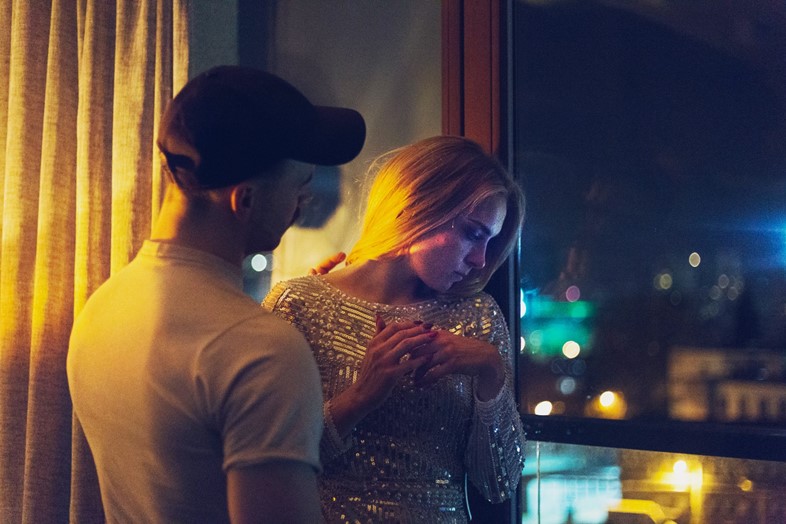Magnus von Horn’s latest film, Sweat, examines the internal and external pressures of sharing your life online
In the opening scene of Sweat, Magnus von Horn’s second full-length feature, Sylwia Zając is in her element. Dressed in tight red sports gear and with brightly-coloured nails, the fitness influencer is on stage in a Polish shopping mall performing for fans. One moment she’s stretching, the next she’s left the stage to “dive into the beautiful energy” of the crowd. She tells them to “work with the body you have, not the one you want to have,” addressing them as “my loves” throughout. Afterwards she’ll ignore the spread laid on, eating instead from Tupperware, before going live on social media to thank her fans, again, for sweating with her.
At first glance, it’s a glowing portrait of a confident young woman with 600,000 Instagram followers and a bright smile. But the film’s tone soon changes as a series of events highlight Slywia’s emotional insecurities: a tense meeting with her agent, a stalker outside her apartment complex, an awkward birthday meal with her mother. “It was very much a reaction to my previous film [The Here After], which was kind of static with pale colours, a dark story and little dialogue,” Von Horn tells AnOther of his objectives going into the picture. “I wanted to make something different, loud, colourful and dynamic. I didn’t want to be a perfectionist.”
Renting a space away from his home in a bid to instil formal working hours and motivate his next project, the Swedish filmmaker instead found himself engrossed in the lives of strangers through his phone. “I have a lot of screen time but I’m not active, I observe people,” he says. This familiar sense of distraction ultimately led him to the world of influencers, and Sweat’s initial premise. “Making a story about an influencer felt like the biggest challenge – it’s so farfetched from myself,” he continues. “In 2015 I started following this fitness motivator on Snapchat. I was fascinated by the posts she did, 80 or 90 a day, with no strategy. She didn’t censor or make it beautiful, her strength was in her rawness. It was so interesting, a new way of storytelling.”

Part of this preoccupation, he notes, was to do with his own feelings about social media and how it both enables narcissism and muddies our understanding of such behaviour. “I was quite judgemental towards her, provoked in a way. A cynical voice asking, ‘how can you use your platform for this when you have so many followers?’ I was wondering why I was negative when she was so happy. A lot of the inspiration [for the film] was about my relationship to the phone – I see that behaviour all over the internet, of negativity, and I know it’s a choice. I called her narcissistic and shallow, but I also felt jealous. I think about a post I will make for a day, so who’s more narcissistic?”
The film was shot over 21 days in Poland, where Von Horn lives, and is his first Polish language feature (The Here After was shot in Sweden). Geographically distant from where many depictions of Instagram culture have appeared on-screen – largely in America – the film engages with its environment, as the country’s social landscape provides an illuminating backdrop to Sylwia’s lifestyle. “The way societies look influences everything. Poland can be quite vulgar – it’s a vulgar society on some levels, polarised politically, religiously – that’s very specific to Poland,” Von Horn says. “The male gaze still runs the show – on motorways billboards sell power drills with bikini girls – but there’s also a strong feminist movement. So you have these different extremes, which makes the influencer arena more extreme.”
Much of Von Horn’s research was phone-based: he spoke to an influencer to learn about the logistics of sponsorship and rewatched Lars von Trier films to negotiate his camerawork too. But for Magdalena Koleśnik, who plays Sylwia, preparation for the film was an intense process. “She went to the gym four times a week and changed her diet,” he says. “She didn’t have Instagram when she got the role, so she had to discover that behaviour – not to pretend to be a fitness influencer, but to be able to do fitness routines and to have that natural hand movement with your phone.”
Koleśnik was attached to the project early on – she was the first person Von Horn met, though being cautious, it took him five months to formally cast her – and the 18 months prep time meant the pair built the character together. “[The film] exists to a certain extent on paper, but it’s what she does with the character,” explains the director. “Filmmaking is a collaboration. It’s not interesting if I tell you how it’s going to be – you get much more from people by accepting their input. And with Magdalena it was about looking for this character; the story is constantly moving, so let’s not pretend we know everything about her.”
The film’s bold moniker, which glows in hot pink across promotional materials, is also the name of Sylwia’s exercise programme – an intentional device by the director to ensure it wouldn’t get translated. “It only works in English,” says Von Horn. “Translated to Polish or Swedish it sounds disgusting, like gym socks, but in English it’s a bit sexy; it has a nice sound and association.” Beyond the aural connotations, it speaks to Sylwia’s life, from her physical training to the internal labour of her psychological welfare. And in the film’s penultimate gut punch, it serves as a combination of the two.
Sweat is in cinemas and Curzon Home Cinema from 25 June 2021.
